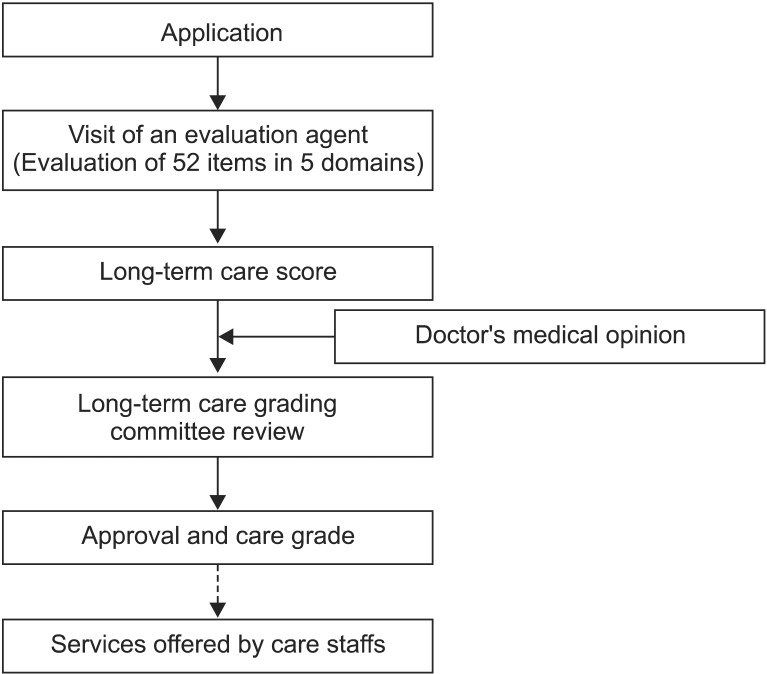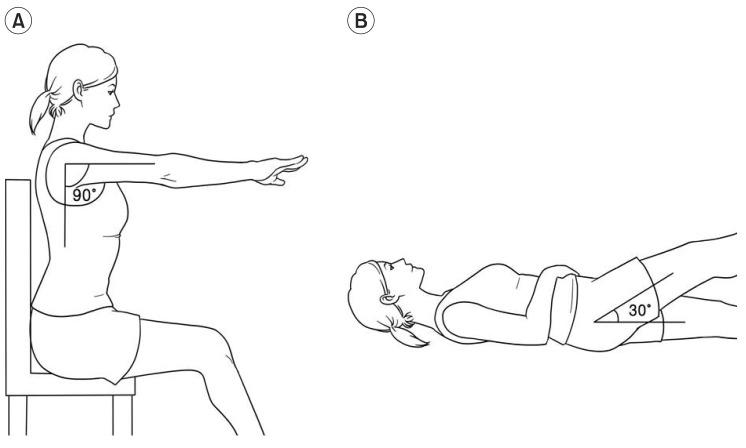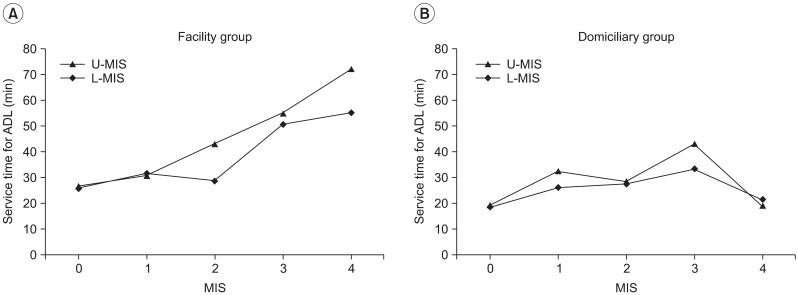Ann Rehabil Med.
2013 Jun;37(3):403-412. 10.5535/arm.2013.37.3.403.
Validity of Motor Impairment Scale in Long-Term Care Insurance System of Korea
- Affiliations
-
- 1Department of Rehabilitation Medicine, Seoul National University College of Medicine, Seoul, Korea. hyungik1@snu.ac.kr
- 2Department of Rehabilitation Medicine, Seoul National University Bundang Hospital, Seongnam, Korea.
- KMID: 2219538
- DOI: http://doi.org/10.5535/arm.2013.37.3.403
Abstract
OBJECTIVE
To validate the Motor Impairment Scale (MIS) of the Korean long-term care insurance (LTCI) system by comparing with the service time offered for aiding activities of daily living (ADL) and the ADL score.
METHODS
A total of 407 elderly subjects without dementia who had used LTCI services were included in this study. Spearman correlations and multivariate linear regression models were employed to determine the relationship of the upper and lower limb MIS (U-MIS and L-MIS, respectively) to the service time and ADL. Stratified analyses for the facility group (n=121) and the domiciliary group (n=286) were performed.
RESULTS
There were significant differences in characteristics between facility group and domiciliary group. The MIS was significantly correlated with service time in facility group (Spearman p=0.41 for U-MIS, Spearman p=0.40 for L-MIS). After adjusting for age, sex, and cognition score, U-MIS was an independent predictor for service time in facility group (p=0.04). In domiciliary group, no significant correlation was found between the MIS and service time. The MIS correlated with all of the ADL items and total ADL score in both groups. After adjusting for other factors including age, sex, and cognitive score, U-MIS and L-MIS were independent variables for explaining the total ADL score in both groups.
CONCLUSION
The validity of the MIS as an evaluation tool in the physically-disabled elderly is higher in facility group than in domiciliary group. As an easy, objective, and simple method, MIS can be a useful tool in the LTCI system of Korea.
MeSH Terms
Figure
Cited by 1 articles
-
Correlation Between Walking Ability and Monthly Care Costs in Elderly Patients After Surgical Treatments for Hip Fractures
Koki Abe, Kazuhide Inage, Keishi Yamashita, Masaomi Yamashita, Akiyoshi Yamamaoka, Masaki Norimoto, Yoshinori Nakata, Takeshi Mitsuka, Kaoru Suseki, Sumihisa Orita, Kazuki Fujimoto, Yasuhiro Shiga, Hirohito Kanamoto, Masahiro Inoue, Hideyuki Kinoshita, Tomotaka Umimura, Yawara Eguchi, Takeo Furuya, Kazuhisa Takahashi, Seiji Ohtori
Ann Rehabil Med. 2018;42(4):569-574. doi: 10.5535/arm.2018.42.4.569.
Reference
-
1. Onishi K. Main medical conditions of frail elderly patients that require intensive care under the Japanese Long-Term Care Insurance (LTCI) system: a comparison with German LTCI. Jpn Hosp. 2011; 30:77–83. PMID: 21879591.2. Houde SC, Gautam R, Kai I. Long-term care insurance in Japan: implications for U.S. long-term care policy. J Gerontol Nurs. 2007; 33:7–13. PMID: 17305264.
Article3. Seok JE. Public long-term care insurance for the elderly in Korea: design, characteristics, and tasks. Soc Work Public Health. 2010; 25:185–209. PMID: 20391261.
Article4. Kim SH, Kim DH, Kim WS. Long-term care needs of the elderly in Korea and elderly long-term care insurance. Soc Work Public Health. 2010; 25:176–184. PMID: 20391260.
Article5. Lee YG, Kim CW, Son CG, Sun WD, Jung KH, Lim JG, et al. A study on the reorganization of long-term care insurance care class judging criteria. Seoul: National Health Insurance Service;2012. Report no. Policy-2012-02.6. Ito H, Tachimori H, Miyamoto Y, Morimura Y. Are the care levels of people with dementia correctly assessed for eligibility of the Japanese long-term care insurance? Int J Geriatr Psychiatry. 2001; 16:1078–1084. PMID: 11746654.
Article7. Campbell AJ, Bunyan D, Shelton EJ, Caradoc-Davies T. Changes in levels of dependency and predictors of mortality in elderly people in institutional care in Dunedin. N Z Med J. 1986; 99:507–509. PMID: 3090485.8. Wang J, Chang LH, Eberly LE, Virnig BA, Kane RL. Cognition moderates the relationship between facility characteristics, personal impairments, and nursing home residents' activities of daily living. J Am Geriatr Soc. 2010; 58:2275–2283. PMID: 21087221.
Article9. Teitelbaum L, Ginsburg ML, Hopkins RW. Cognitive and behavioural impairment among elderly people in institutions providing different levels of care. CMAJ. 1991; 144:169–173. PMID: 1986829.10. Sakai Y, Mori S, Nakajima K. Development of a tree model that allows simple estimation of the required care level using the items of the basic investigation of long-term care insurance. Nihon Ronen Igakkai Zasshi. 2002; 39:537–544. PMID: 12404751.
Article11. Won CW, Rho YG, Kim SY, Cho BR, Lee YS. The validity and reliability of Korean activities of daily living (K-ADL) scale. J Korean Geriatr Soc. 2002; 6:98–106.12. Kwon YC, Park JH. Korean version of mini-mental state examination (MMSE-K) part I: development of the test for the elderly. J Korean Neuropsychiatr Assoc. 1989; 28:125–135.13. Tsutsui T, Muramatsu N. Care-needs certification in the long-term care insurance system of Japan. J Am Geriatr Soc. 2005; 53:522–527. PMID: 15743300.
Article14. Kim HS, Bae NK, Kwon IS, Cho YC. Relationship between status of physical and mental function and quality of life among the elderly people admitted from long-term care insurance. J Prev Med Public Health. 2010; 43:319–329. PMID: 20689358.
Article15. Imahashi K, Kawagoe M, Eto F, Haga N. Clinical status and dependency of the elderly requiring long-term care in Japan. Tohoku J Exp Med. 2007; 212:229–238. PMID: 17592210.
Article16. Shinkai S, Watanabe N, Yoshida H, Fujiwara Y, Amano H, Lee S, et al. Research on screening for frailty: development of "the Kaigo-Yobo Checklist". Nihon Koshu Eisei Zasshi. 2010; 57:345–354. PMID: 20666121.17. Tomata Y, Hozawa A, Ohmori-Matsuda K, Nagai M, Sugawara Y, Nitta A, et al. Validation of the Kihon Checklist for predicting the risk of 1-year incident long-term care insurance certification: the Ohsaki Cohort 2006 Study. Nihon Koshu Eisei Zasshi. 2011; 58:3–13. PMID: 21409818.18. Hirai H, Kondo K, Ojima T, Murata C. Examination of risk factors for onset of certification of long-term care insurance in community-dwelling older people: AGES project 3-year follow-up study. Nihon Koshu Eisei Zasshi. 2009; 56:501–512. PMID: 19827611.19. Goodlin S, Boult C, Bubolz T, Chiang L. Who will need long-term care? Creation and validation of an instrument that identifies older people at risk. Dis Manag. 2004; 7:267–274. PMID: 15671784.
Article20. Resnick B, Galik E. The reliability and validity of the physical activity survey in long-term care. J Aging Phys Act. 2007; 15:439–458. PMID: 18048947.
Article21. Glick OJ, Swanson EA. Motor performance correlates of functional dependence in long-term care residents. Nurs Res. 1995; 44:4–8. PMID: 7862544.
Article22. Nemoto M, Yabushita N, Kim MJ, Matsuo T, Seino S, Tanaka K. Assessment of vulnerable older adults' physical function according to the Japanese long-term care insurance (LTCI) system and Fried's criteria for frailty syndrome. Arch Gerontol Geriatr. 2012; 55:385–391. PMID: 22100110.
Article
- Full Text Links
- Actions
-
Cited
- CITED
-
- Close
- Share
- Similar articles
-
- Korean Elderly Long-term Care Insurance System and Long-term Care Hospital
- Long-Term Care System in Korea
- The Long-term Care Management for the Elderly in Korea
- Long-term Care of Dementia
- Longitudinal Effects of Health Status on Changes in the Use of the Elderly Long-Term Care Insurance System of Older Adults in Korea




